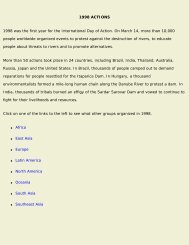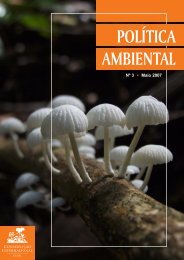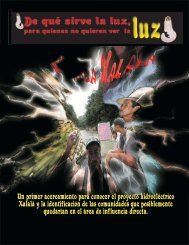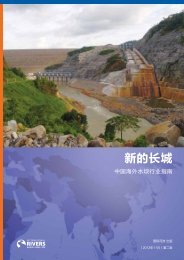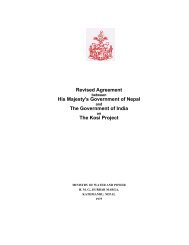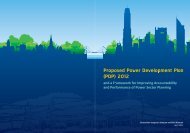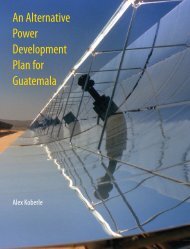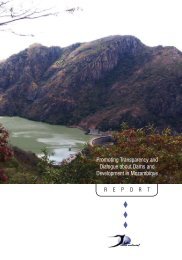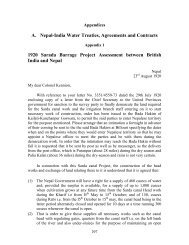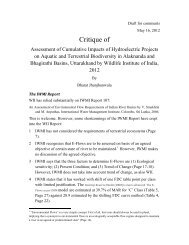Sources <strong>of</strong> FinancingThe financing sources <strong>of</strong> these dams are likely to differ from country to country, as the four countries have differingeconomic situations. In general, the private sector is expected to play a more significant role than in the past in allfour countries, with governments hoping that it will help meet the huge requirements <strong>of</strong> funds. <strong>International</strong> FinancialInstitutions (IFIs) like the World Bank and the ADB are likely to play an important role in Nepal and Bhutan, as are thegovernment <strong>of</strong> India, Indian companies and some bilateral donors. In Pakistan, IFIs, China and domestic resources arethe likely sources <strong>of</strong> funds. In India, the government, public and private developers, Indian banks and Indian financialinstitutions are likely to be the biggest players, although given the size <strong>of</strong> the program there will also be a host <strong>of</strong>national and international players.BhutanThe Indian government will be a major funder <strong>of</strong> dams inBhutan. The Chukha (336 MW), Kurichhu (60 MW) andTala (1,020 MW) projects have been financed entirely bythe government <strong>of</strong> India with 60% <strong>of</strong> the money coming asgrants and 40% as loans with interest rates from 5-10.75%.Indian cooperation also extends to the construction <strong>of</strong>transmission lines to bring the power to India. The proposedPunatsangchu-I project (1,095 MW) will also be financedentirely by India as per the Indo-Bhutan Punatsangchu-IAgreement <strong>of</strong> July 28, 2007, but with terms changed to 40%as a grant and 60% as a loan. 49Bhutan estimates that it will need Nu 123 billion ($3billion) in the 10 th Plan period (2008-2013) for the firststage <strong>of</strong> the 10,000 MW development. 50 The government<strong>of</strong> Bhutan is proposing to use Nu 40 billion ($950 million)<strong>of</strong> the Nu 100 billion ($2.4 billion) committed by Indiatowards the 10 th Plan. It is not clear whether this includesassistance for the Punatsangchu-I project or not. There isalso no clarity about the source for the remaining funds,except that they will come from loans. Even if we assumethat the Indian contribution will pay for Punatsangchu andanother Nu 40 billion, this comes to about $1.85 billion,leaving a shortfall <strong>of</strong> more than one billion dollars. And thisis only the first stage, which accounts for a mere 25% <strong>of</strong> thetotal funds. Bhutan will need to bring in over $9 billion inthe second stage. This is where IFIs are likely to play a role.While the World Bank is not directly involved infinancing hydropower in Bhutan at the moment, the ADBis directly supporting it. According to the ADB’s “2008 FactSheet on Bhutan,” the “ADB and the Government haveagreed to focus assistance on transport, power (includingrural electrification), urban development, and financial andprivate sector development.” 51 The ADB also provided aTechnical Assistance grant (TA), “Preparing the BhutanPower Development,” in 2007. 52 Among the objectives <strong>of</strong>the TA are the acceleration <strong>of</strong> hydropower development andprivate sector participation, 53 including preparations for the114 MW Dagachu project. This TA will also devise financialpackages from “public and private investors and lenders,including bilateral and multilateral banks, or export creditagencies.” A related grant and loan are expected to followthis TA. The ADB has also recently approved a TA entitled“Promotion <strong>of</strong> Clean Power Export Development” that willresult in, among other things, a “strategy and action planto broaden financing avenues for future large hydropowerprojects.” 54 Thus, the ADB is set to mobilize a set <strong>of</strong>international financiers, private and public, for hydropowerprojects in Bhutan. The ADB has also provided a $62.24million private-sector loan for laying the transmission linesfrom Siliguri to New Delhi in India to transport power fromthe 1,020 MW Tala Hydroelectric Project in Bhutan. 55Bhutan hopes to build projects totalling about 7,000MW through joint ventures with the government <strong>of</strong> India.It hopes to pull in private capital for the remaining 3,000MW on a build-own-operate-transfer (BOOT) basis, andthe new hydropower policy is a step in this direction.Apparently, Indian companies like Tata, Reliance, GMR,Lanco, Jai Prakash, Green Infrastructure Development, andeven a few companies from Norway and South Korea, haveexpressed interest. 56 Tata Power <strong>of</strong> India has become the firstprivate company to invest/have ownership in a hydropowerproject in Bhutan, with the company having taken a 26%share in the 114 MW Dagachu Power Project in January2008. 57NepalNepal is following a two-pronged approach to fund itshydropower program. The relatively modest program for itsinternal requirements would be funded by NEA’s internalresources, funds raised from the domestic market, andbilateral and multilateral aid agencies. The projects that aremeant for power exports to India will be executed by publicor private companies under Public-Private Partnerships12 | <strong>International</strong> <strong>Rivers</strong>
(PPPs), or through privatization where they would raisetheir own money, backed by the promise <strong>of</strong> the Indianpower market. Nepal would get some free power and possiblysome equity in these projects.Thus, the NEA plans to issue power bonds to the tune<strong>of</strong> NR 3 billion ($43.5 million) to fund the Chameliya,Kulekhani-III and Middle Marsyangdi projects. It isalso planning to raise domestic financing for the UpperTamakoshi project. 58The German government is partially financing theMiddle Marsyangdi project through the Kreditanstalt fürWiederaufbau (KfW), a German government-owned bankthat supports economic, social and ecological developmentworldwide. S<strong>of</strong>t loans from China are expected to support the60 MW Trishuli-3A project and the Nepalese governmenthas recently requested support from China for the 122 MWUpper Seti project.On the other hand, MoUs have been signed withcorporations to build projects like the 750 MW West Seti(SMEC), 300 MW Upper Karnali (GMR Consortium) and402 MW Arun-III (Satluj Jal Vidyut Nigam Ltd.) projects,primarily to export power to India; these companies willraise their own funds. The sources for these funds could bediverse, including Indian and international banks, financingagencies, bonds, export credit agencies, and even IFIs as theWest Seti case shows. [See Box 1, page 14] The Indian marketwill be the ultimate backer <strong>of</strong> these funds, and thus, thepolicies and incentives associated with the sale <strong>of</strong> electricityin India, discussed further on in this report, will influencethe funding <strong>of</strong> these projects in Nepal, too.Recent developments suggest that Nepalese-Indiancooperation in the field <strong>of</strong> water resources could pick uppace. If this happens, there could be direct Indian governmentfunding for projects like the 207 MW Naumure and themassive 6,480 MW Pancheswar multi-purpose projects.The ADB is likely to be a very important source <strong>of</strong>funds for hydropower projects in Nepal. It is consideringsupporting the West Seti project in multiple ways – a PrivateSector Loan <strong>of</strong> $50 million, a Political Risk Guarantee <strong>of</strong>$68.5 million and an Equity Investment <strong>of</strong> $40.8 million. 59There is also a $45 million loan proposed to the Nepaligovernment for it to invest in the project. The ADB hasa TA, “Transmission and Distribution Project” that willfacilitate the preparation <strong>of</strong> transmission and distributionexpansion and reinforcement projects. The ADB has alsoapproved a TA, “Promoting Private Sector Participation inthe Power Sector,” that will develop policy and regulationsto encourage private participation in Nepal’s domestic andexport-oriented hydropower programs. 60PakistanInternal resources like the PSPD – Public SectorDevelopment Plan (government finances) and specialcharges like surcharges on power sold (e.g. a 10 paisa perThe Karnali River downstream <strong>of</strong> the planned Upper Karnali project,2008. Upper Karnali is estimated to cost $454 million (1998estimate) which is about half the total annual revenue <strong>of</strong> Nepal.Photo: Shripad DharmadhikaryKWh surcharge for the Neelum Jhelum project), supportfrom China, and IFIs like the World Bank and the ADBare likely to be the main sources <strong>of</strong> funds for projects inPakistan. Foreign private banks, Export Credit Agencies(ECAs) and external commercial borrowings could also playa role in Pakistan.The ADB has funded virtually all the large hydropowerprojects in Pakistan to date – Tarbela, Mangla and GazhiBarotha. 61 Key priorities for the ADB in Pakistan nowinclude reforms and investment in major infrastructure –two <strong>of</strong> three key sectors being power and energy, and waterand irrigation. This will likely mean the institution willsupport future big dam construction. Currently active ADBprojects in the power sector include support for investmentsin power transmission and promotion <strong>of</strong> the private sector.The World Bank has been involved in supporting theTarbela, Mangla and the Gazhi Barotha projects. The WorldBank’s “Pakistan Country Water Strategy” argues stronglyfor large storage dams in the country and also says that “thevery large hydropower potential [<strong>of</strong>fers] possibilities forraising substantial amounts <strong>of</strong> private financing.” 62The $38 million “Water Sector Capacity Building andAdvisory Services Project” (WCAP) was approved on June6, 2008 by the World Bank. The objectives <strong>of</strong> this projectinclude:D a m s , R i v e r s & P e o p l e | 1 3




